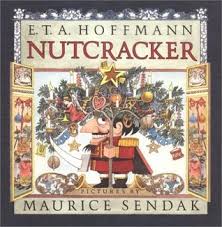The Other Nutcracker
Listen to the Recess! Clip
| Author | Kevin Shortsleeve |
| Air Date | 12/23/2002 |

The Other Nutcracker Transcript
Wooden nutcrackers arose from the old German tradition of hanging nuts dipped in goldleaf on a Christmas Tree. Something equally decorative was needed to open these festive nuts. From the fanciful, functional figurines created in the Saxony region of Germany, folk legends were born about enchanted nutcrackers, and these legends spread throughout Bohemia and Poland.
In 1816, the “King” of all nutcracker stories was published by the German author, Ernst Theodore Hoffmann. He’s usually known as E. T. A. Hoffmann. His Nutcracker and the Mouse King is filled with dark, supernatural characters, evil spells and a terrible seven-headed Mouse King. Hoffman put himself in the story, as the gift-bearing Uncle Drosselmeyer, who arrives on Christmas Eve with a paste-board castle for the children, a gift that in reality Hoffman had recently constructed for the children of a friend. The story was published to much success, Hoffman even receiving congratulations from a Prussian general who complimented him on his skill as a military strategist in the battle scenes between the tin soldiers and the mice.
In 1845, Alexander Dumas, author of The Three Musketeers, published a less dark, sweeter version of Hoffmann’s tale. And in 1890, it was this version that was read by the director of the Imperial Opera in St. Petersburg, Russia, who thought it might make a good ballet, and who asked Peter Tchaikovsky to compose music for it. Tchaikovsky, who had read and liked the original, darker Hoffman version, was at first reluctant to take on the project. But in 1891, he relented, and began work on the composition.
Tchaikovsky incorporated a number of children’s musical instruments and eventually a rattle, a toy trumpet, a miniature drum and a cuckoo clock were written into the score. He also discovered a new instrument called a Celeste. It sounded something like a toy piano, and his use of it in “The Dance of the Sugar Plum Fairy” marked the premier of that instrument in orchestral music.
The Nutcracker of Hoffmann, Dumas and Tchaikovsky has gone on to be reinterpreted, time and again, from Disney’s Fantasia to Maurice Sendak’s stage production and picture book to the 1996 production of a Nutcracker, set in today’s Harlem, and featuring Duke Ellington’s arrangement of Tchaikovsky’s music. Throughout all these versions and revisions, the basic appeal of The Nutcracker has remained the same as it was hundreds of years ago in Saxony when children huddled round to hear, how once upon a time, the toys came to life — when the bells chimed midnight — on Christmas Eve.
Sources
http://www.balletmet.org/Notes/NutHist.html#anchor65579
The Oxford Companion to Fairy Tales
The Oxford Companion to Children’s Literature
“Beloved Friend”, The Story of Tchaikovsky and Nadia Von Meck, by Catherine Bowen.
The Selected Letters of E.T.A. Hoffman. Edited by Johanna Sahlin Hoffman, Author of Tales, by Harvey Hewett-Thayer
Encyclopedia Britannica
The Story of the Nutcracker Ballet by Deborah Hautzig.